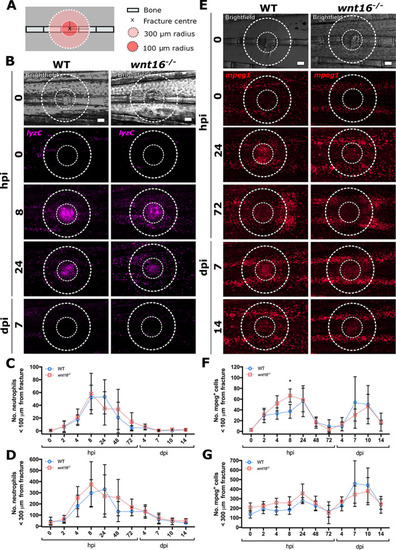
Loss of Wnt16 does not perturb leukocyte recruitment to bone postfracture. Fractures were induced in WT and wnt16−/− zebrafish carrying lyzC:DsRed and mpeg1:mCherry transgenes to measure the recruitment of neutrophils and macrophages, respectively. (A) Schematic depicting regions of interest around the fracture site where leukocyte recruitment was quantified. (B) Representative images of from WT and wnt16−/− zebrafish show neutrophil (lyzC+ cells) recruitment to fractured bone at 0, 8, and 24 hours postinjury (hpi) and 7 days postinjury (dpi). Scale bar = 100 μm. (C,D) The number of neutrophils within 100 μm (C) and 300 μm (D) of the fractures were quantified in an automated manner using modular image analysis (MIA) from 0 hpi to 14 dpi. WT and wnt16 mutants displayed comparable numbers of neutrophils at the fracture site at all time points post injury. N ≥ 5 per genotype. (E) Representative images of from WT and wnt16−/− zebrafish show macrophage (mpeg1+ cells) recruitment to fractured bone at selected time points from 0 to 14 dpi. Scale bar = 100 μm. (F,G) The number of neutrophils within 100 μm (F) and 300 μm (G) of the fractures were quantified using MIA from 0 hpi to 14 dpi. WT and wnt16 mutants displayed comparable numbers of macrophages at all time points postinjury, with the exception of 8 hpi when wnt16 mutants had recruited significantly more macrophages to within 100 μm of the fracture site (F). *p < 0.05; N ≥ 5 per genotype.
|

